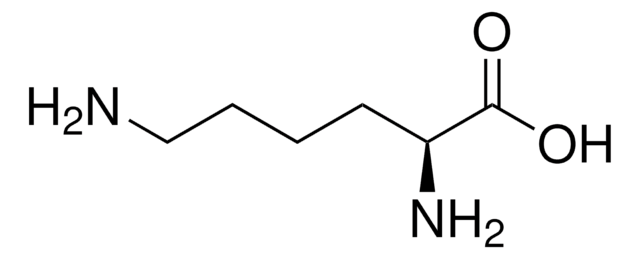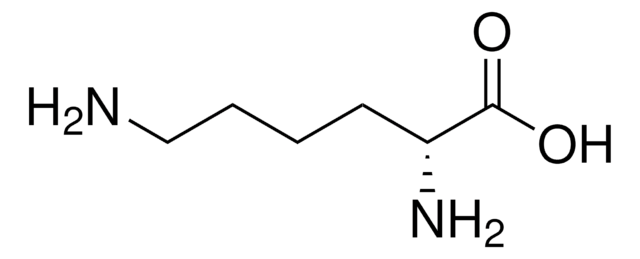W384720
L-Lysine
≥98%, FG
Synonym(s):
(S)-2,6-Diaminocaproic acid
About This Item
Recommended Products
biological source
synthetic
Quality Level
grade
FG
Halal
Kosher
Agency
meets purity specifications of JECFA
reg. compliance
EU Regulation 1334/2008 & 178/2002
FDA 21 CFR 117
FDA 21 CFR 172.320
Assay
≥98%
mp
215 °C (dec.) (lit.)
application(s)
flavors and fragrances
Documentation
see Safety & Documentation for available documents
food allergen
no known allergens
Organoleptic
odorless
SMILES string
NCCCC[C@H](N)C(O)=O
InChI
1S/C6H14N2O2/c7-4-2-1-3-5(8)6(9)10/h5H,1-4,7-8H2,(H,9,10)/t5-/m0/s1
InChI key
KDXKERNSBIXSRK-YFKPBYRVSA-N
Looking for similar products? Visit Product Comparison Guide
Application
- Novel recombinant aminoacylase from Paraburkholderia monticola capable of N-acyl-amino acid synthesis: Discusses a new enzyme capable of utilizing L-Lysine for synthesizing N-acyl-amino acids, paving the way for advancements in biochemical syntheses and industrial applications (Haeger et al., 2024).
Storage Class Code
11 - Combustible Solids
WGK
WGK 1
Flash Point(F)
Not applicable
Flash Point(C)
Not applicable
Choose from one of the most recent versions:
Already Own This Product?
Find documentation for the products that you have recently purchased in the Document Library.
Customers Also Viewed
Our team of scientists has experience in all areas of research including Life Science, Material Science, Chemical Synthesis, Chromatography, Analytical and many others.
Contact Technical Service





